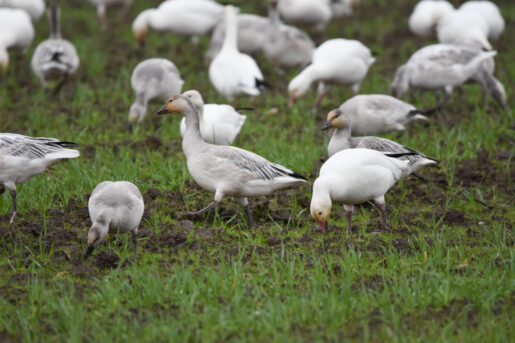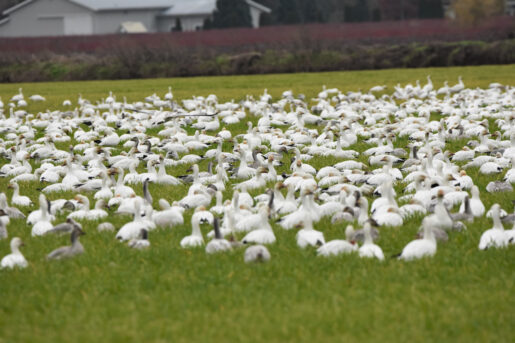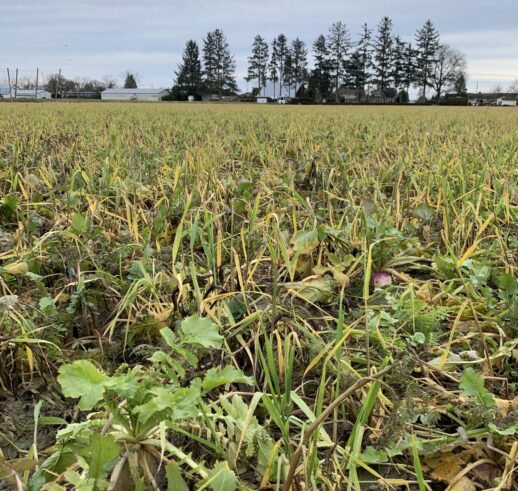Cover Crop Stewardship Program
What is it?
Every winter, the Fraser River Estuary hosts hundreds of thousands of waterfowl during their annual migration and overwintering. As food sources for the waterfowl have disappeared due to urbanization and industrialization, many species have become dependent on farmland for forage.
DFWT partners with farmers to plant cover crops in fields to draw the hungry birds away from surrounding, higher-value crops and sports fields. The cover crops also help farmers maintain soil productivity by preventing erosion from winter rain and wind, and by increasing organic matter in the soil.
Cover crop plantings also provide ecosystem services for the community by protecting the local food supply
and recreational fields, and by providing services like flood management, water filtration, and wildlife conservation.
How does it benefit wildlife?
The Fraser River Estuary is located along the Pacific Flyway, a major north-south route for migratory birds that extends from Alaska to Patagonia. Every year, over 5 million migratory birds pass through this area, many stopping to refuel and rest during their long journeys.
The estuary supports the largest density of over-wintering birds in Canada, and is considered Canada’s top Important Bird Area (IBA), with 15 species that are of global and continental importance. Cover crops provide food for visiting waterfowl species, including:
• Wrangel Island Lesser Snow Geese
• Trumpeter Swans (a previously endangered species)
• Dabbling ducks, including the American Wigeon, Northern Pintail, Mallard, and Green-Winged Teal
• Wild goose species, including Canada Goose, Greater White-fronted Goose, and Cackling Goose


Winter cover crops help to manage large flocks of visiting Snow Geese
Snow Geese are among the most visible visitors – and some of the most difficult to manage when their search for food comes into conflict with human activity. The birds breed during the warm season on Wrangel Island in Russia, then migrate in October to southwest BC, staying mostly in Delta and Richmond. In March, the geese head north again. In the 1970s, the over-wintering population of Snow Geese in the Fraser Valley was estimated at approximately 15,000; by 2020 it was estimated at between 200,000 and 220,000.
Whether they are grazing on playing fields, or congregating in large flocks on the foreshore marsh of Sea Island directly in the path of approaching and departing aircraft at Vancouver International Airport, the geese can pose a problem. Unlike Canada Geese, Snow Geese feast on the roots of grasses, as well as the blades, sometimes overgrazing fields to the ground. Cover crops act as a lure, drawing some of the waterfowl away from dangerous areas and high-value fields by providing them with an alternative source of food from mid-fall to early spring.
How does it benefit farmers?
Waterfowl grazing can be very costly for farmers. When their fields of forage grass are overgrazed by species such as Snow Geese and American Wigeon, dairy farmers have to purchase replacement feed for their herd, and may have to reseed fields that have been grazed to the ground, or incur losses from reduced spring yields.
In addition, when large flocks of heavy waterfowl, like geese, land on the delta’s wet clay soil they compact the ground. It becomes more difficult to till the field, for plant roots to penetrate the soil, and for air and water to infiltrate the ground. The field remains wet and cool long into the growing season, and crop production is negatively affected.
Fields planted with cereal grasses in the late summer and early fall provide feeding habitat for the waterfowl and lure them away from perennial forage fields. They also help to maintain soil health, as empty fields are more vulnerable to erosion from heavy rain and strong winds, and nutrient-leaching from pooling water. Cover crops help to:
- Protect soil from erosion
- Improve soil quality by providing food and habitat for soil microorganisms
- Scavenge excess nutrients, such as nitrogen, from the soil before they leach away
- Improve water infiltration; rainwater moves through the soil instead of running off, and the ground holds the water long enough for plants and organisms to benefit
- Suppress late season weeds
- Add organic matter to the soil when the crops are tilled under at the beginning of the next growing season
- Increase long-term crop yields
- Reduce the need for fertilizers and herbicides
You can read more about the benefits of cover crops in our blog.
How do DFWT and farmers work together to deliver the program?
Farmers in the Fraser delta have been planting winter cover crops since 1990, both to provide winter forage for migratory waterfowl and to increase soil productivity. Between 1990 and 2023, Delta farmers partnered with DFWT to plant approximately 90,000 acres of winter cover crops.
Spring cereals (barley, oats, spring wheat) and winter cereals (fall rye, winter wheat) are planted in late summer/early fall, after cash crops are harvested. Through the Cover Crop Program, DFWT offers a cost-share to participating farmers to assist with planting costs and to incentivize the practice.


What our research shows:
• Waterfowl forage in higher densities on fields with a cover crop, versus fields without.
• More than half the fields planted with cover crops each year are completely grazed to the soil surface by waterfowl.
• Several studies show that both Snow Geese and American Wigeon will graze cereal cover crops before grazing perennial forage grasses.
• Increasingly, Snow Geese graze on fields at night – learn how DFWT is using audio recorders to monitor them.
Want to learn more?
Every winter, DFWT monitors waterfowl presence on farmland in Delta, Richmond, and Abbotsford to understand how and where waterfowl are using agricultural fields. We also measure the amount of grazing that has occurred on cover crop fields throughout the season. You can read our reports here.

You can help us track waterfowl in Metro Vancouver!
Delta Farmland and Wildlife Trust is teaming up with the citizens of Metro Vancouver and the Fraser Valley to monitor Snow Geese and other waterfowl activity, and improve our understanding of how and why Snow Geese move throughout the region. When you see geese, ducks or swans on farm fields, you can submit your sighting online to our waterfowl tracker here.
How Can You Help?
Your donation will work towards conserving important farmland and wildlife resources contained in the Fraser River delta.
